Commercial Salamander Guide
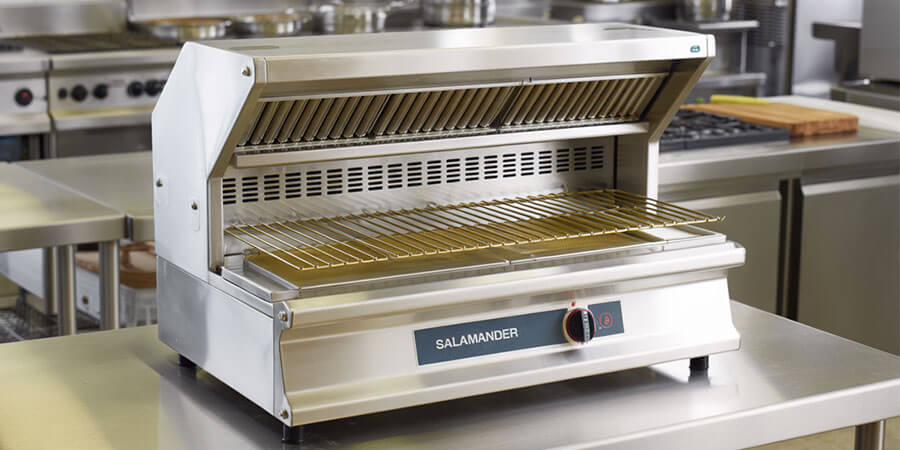
Table of Contents
Essential high-heat finishing equipment for professional kitchens
Commercial salamanders are specialized high-heat cooking appliances designed for finishing, browning, and melting tasks in professional kitchens. These overhead broilers provide intense infrared heat to quickly caramelize sugars, melt cheese, brown toppings, and add crispy finishes to dishes. Essential for restaurants, catering operations, and commercial kitchens, salamanders offer precise temperature control and rapid heating to enhance presentation and flavor without overcooking the base food. From countertop electric models to gas-powered units, choosing the right salamander depends on your kitchen's power capabilities, cooking volume, and space constraints.
Key Applications in Commercial Kitchens
- Caramelizing sugars on desserts like crème brûlée
- Browning and crisping proteins (steaks, chicken, fish)
- Toasting bread and finishing baked goods with adjustable height
- Browning toppings on casseroles and gratins
- Finishing vegetables with crispy exteriors
- Creating cheese crusts on hot dishes and appetizers
- Maintaining food temperature during high-volume service
Salamanders provide overhead infrared heating for browning, melting, and finishing tasks in commercial kitchens. Electric, gas, and infrared models offer different power options with adjustable height controls for precise heat application.
Types of Commercial Salamanders
Commercial salamanders are categorized by heat source, power level, and installation type. Each offers different advantages for various kitchen setups and cooking volumes.
Infrared Salamanders
Infrared salamanders use focused infrared heating elements for efficient, even heat distribution. These units heat up quickly and provide consistent performance for high-volume operations.
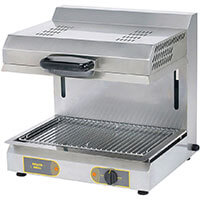
- Best Uses: High-volume restaurants, quick-service operations, busy commercial kitchens requiring rapid heat-up and consistent results
- Capacity: 2.4-4 kW power output; 16-18 amps at 240V
- Features: Stainless steel construction, adjustable height (8"-2.75" range), removable drip trays, infinite control dials
- Pros: Fast heating, precise temperature control, energy efficient, consistent results
- Cons: Requires 240V electrical service, higher initial cost
Gas Salamanders
Gas-powered salamanders deliver high BTU output for heavy-duty commercial applications. These models are ideal for kitchens with gas service and high-volume finishing needs.
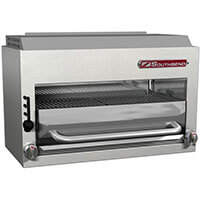
- Best Uses: Full-service restaurants, catering operations, banquet facilities requiring continuous high-heat performance
- Capacity: 25,000-40,000 BTU output; natural gas or propane options
- Features: Cast iron burners, adjustable gas valves, wall-mount or riser installation
- Pros: High heat output, continuous operation, fuel efficiency for heavy use
- Cons: Requires gas line installation, ventilation considerations, higher maintenance
Electric Salamanders
Electric salamanders offer flameless operation with consistent heating elements. These are suitable for kitchens without gas service or where ventilation is a concern.
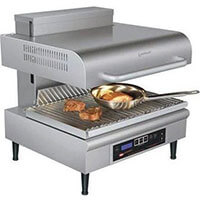
- Best Uses: Restaurants without gas lines, cafes, smaller operations, facilities with ventilation restrictions
- Capacity: 2.4-4.35 kW power output; 115V-240V options
- Features: Quartz or metal heating elements, countertop or wall-mount designs
- Pros: Easy installation, flameless operation, precise control, lower maintenance
- Cons: Limited heat output compared to gas, requires dedicated electrical circuits
Countertop Salamanders
Countertop models sit on existing work surfaces and are ideal for smaller kitchens or specialized finishing stations.
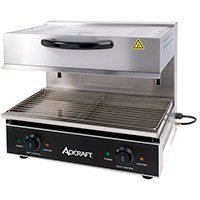
- Best Uses: Smaller restaurants, prep areas, dessert stations, limited-space operations
- Capacity: 2.4-4 kW electric models; compact footprint (18"-24" wide)
- Features: Portable design, adjustable height controls, removable components
- Pros: Flexible placement, lower cost, easy to move
- Cons: Limited to lighter-duty applications, occupies counter space
Range-Mounted Salamanders
Range-mounted units attach to existing commercial ranges or ovens, creating an integrated cooking station.
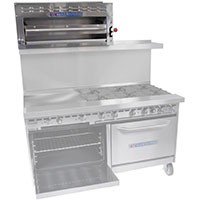
- Best Uses: Range-equipped kitchens, traditional restaurant layouts, operations needing combination cooking
- Capacity: Matches range specifications; electric or gas options
- Features: Integrated with range controls, shared ventilation, riser mounting
- Pros: Space efficient, integrated operation, utilizes existing infrastructure
- Cons: Limited to kitchens with compatible ranges, less flexibility
Wall-Mount Salamanders
Wall-mounted salamanders save counter space by attaching directly to walls or above work areas.
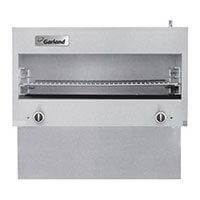
- Best Uses: Space-constrained kitchens, above prep tables, assembly-line cooking setups
- Capacity: 2.4-4 kW electric models; wall-mount brackets included
- Features: Fixed height installation, adjustable angle, compact design
- Pros: Frees counter space, ergonomic placement, stable operation
- Cons: Permanent installation, limited height adjustment
Salamander Type Comparison
| Type: | Heat Source: | Best For: | Power Output: | Installation: |
| Infrared | Electric | High-volume kitchens | 2.4-4 kW | Countertop/Wall |
| Gas | Natural Gas/Propane | Heavy-duty operations | 25k-40k BTU | Wall/Riser |
| Electric | 115V-240V | Smaller operations | 2.4-4.35 kW | Countertop/Wall |
| Countertop | Electric | Limited space | 2.4-4 kW | Countertop |
| Range-Mounted | Electric/Gas | Integrated setups | Varies | Range attachment |
| Wall-Mount | Electric | Space saving | 2.4-4 kW | Wall mounted |
*Note: Power requirements vary by model; always check electrical/gas specifications.*
Selection Factors
Choosing the right salamander requires careful consideration of your kitchen's requirements and operational needs.
Heat Source & Capacity
Match the heat output to your cooking volume and power availability:
- Electric (2.4-4.35 kW): Best for moderate use, requires 115V-240V circuits
- Gas (25k-40k BTU): Ideal for high-volume operations with gas service
- Infrared: Most efficient for consistent, rapid heating
Size & Installation Requirements
Consider your available space and installation options:
- Countertop: 18"-24" wide × 16"-21" deep × 16"-21" high
- Wall-mount: Requires 24"-30" clearance above work surface
- Range-mounted: Must match existing range specifications
- Weight: 50-113 lbs depending on model and construction
Power Requirements & Energy Efficiency
Ensure your electrical system can support the salamander:
- Voltage: 115V or 240V dedicated circuits required
- Amperage: 12-18 amps for most electric models
- Gas: Natural gas or propane lines with proper ventilation
- Efficiency: Infrared models offer best energy efficiency
Safety Features & Certifications
Prioritize equipment with safety considerations:
- Cool-touch handles: Bakelite or heat-resistant materials
- Non-slip feet: Rubber feet for stability
- Overheat protection: Automatic shutoff features
- NSF certification: Required for commercial foodservice
- UL listing: Electrical safety certification
Price Range & Budget Considerations
Factor in total cost of ownership:
- Entry-level: $300-500 (basic electric countertop models)
- Mid-range: $500-800 (commercial-grade electric units)
- Premium: $800+ (gas models, high-capacity infrared units)
- Installation: Additional costs for electrical/gas modifications
Usage & Operation Guide
Proper operation ensures optimal performance and food safety.
Basic Operation Steps
- Pre-heat the salamander: Turn on unit 10-15 minutes before use to reach operating temperature
- Adjust height: Position heating element 2-6 inches above food surface
- Use proper cookware: Metal plates, skillets, or broiler-safe ceramic dishes only
- Monitor closely: High heat works quickly - check every 30-60 seconds
- Allow proper clearance: Maintain 1-2 inches between food and heating element
Temperature Settings for Different Foods
- Cheese melting: Low to medium heat (2-4 inches from element), 30-60 seconds
- Bread toasting: Medium heat, 1-2 minutes for golden brown
- Sugar caramelizing: High heat, 30-45 seconds for crème brûlée
- Protein browning: Medium-high heat, 1-2 minutes for crust formation
- Vegetable finishing: Medium heat, 45-90 seconds for color and texture
Heat Source Selection Tips
- Electric/Infrared: Best for precise control and consistent results
- Gas: Ideal for high-volume continuous operation
- Countertop models: Perfect for smaller portions and quick tasks
- Range-mounted: Excellent for integrated cooking workflows
Maintenance & Cleaning
Regular maintenance ensures longevity and food safety.
Daily Cleaning Procedures
- Unplug or turn off: Always disconnect power before cleaning
- Allow cooling: Wait until unit reaches safe temperature
- Remove components: Drip trays, grates, and removable parts
- Dispose of debris: Empty drip trays into approved containers
- Wipe surfaces: Use mild detergent and damp cloth on exterior
- Clean heating elements: Gentle wiping only - avoid abrasive cleaners
- Dry thoroughly: Prevent moisture buildup and corrosion
Weekly Maintenance Tasks
- Deep clean stainless steel surfaces with appropriate cleaners
- Inspect heating elements for damage or buildup
- Check electrical connections and cords for wear
- Clean ventilation areas and exhaust paths
- Lubricate moving parts as recommended by manufacturer
Safety Precautions
- Never leave unattended: High heat can cause fires or burns
- Use heat-resistant tools: Metal or heat-safe utensils only
- Wear protective gear: Oven mitts and long sleeves when operating
- Maintain clearance: Keep flammable materials away from heating elements
- Proper ventilation: Ensure adequate exhaust systems for gas models
Common Issues & Troubleshooting
- Uneven heating: Adjust height or clean heating elements
- Excessive smoke: Reduce heat or clean drip trays more frequently
- Tripped circuit: Check electrical load and circuit capacity
- Warped cookware: Use only heat-resistant, flat cooking surfaces
Cheese Melters vs Salamanders
Understanding the differences helps you choose the right equipment for your specific finishing needs.
Key Differences
Salamanders:
- Primary Function: Versatile high-heat finishing with adjustable height control
- Heat Control: Adjustable height (2.75"-8" range) for different food thicknesses
- Power Range: 2.4-4 kW electric, 25k-40k BTU gas (higher heat output)
- Best For: Browning, caramelizing, toasting, high-heat finishing tasks
- Features: Height adjustment, broader finishing capabilities, higher temperature range
Cheese Melters:
- Primary Function: Specialized for cheese melting and light browning
- Heat Control: Fixed height, focused infrared heat for cheese applications
- Power Range: 1.6-4.2 kW electric, 20k-60k BTU gas (moderate heat)
- Best For: Pizza shops, sandwich operations, cheese-focused menu items
- Features: Plate-activated heating, energy-efficient for cheese applications
When to Choose a Salamander
- Need adjustable height for different food types and thicknesses
- Require higher heat output for browning and caramelizing
- Menu includes diverse finishing tasks beyond cheese melting
- Prefer versatile equipment for multiple high-heat applications
When to Choose a Cheese Melter
- Primary menu items involve cheese melting (pizzas, sandwiches, nachos)
- Space constraints favor specialized equipment
- Energy efficiency for cheese-focused operations is important
- Lower heat requirements for your menu items
Hybrid Considerations
- High-volume operations: May benefit from both - cheese melter for primary cheese work, salamander for specialty finishing
- Space permitting: Both can complement each other in busy kitchens
- Menu analysis: Review your menu to determine primary vs. secondary needs
Frequently Asked Questions
What's the difference between a salamander and a broiler?
Salamanders provide overhead infrared heat from above, while traditional broilers heat from below. Salamanders offer more precise control and are designed for finishing tasks rather than primary cooking.
How long does a salamander take to heat up?
Most electric salamanders reach operating temperature in 10-15 minutes. Gas models heat up slightly faster but require proper ventilation during warm-up.
Can salamanders be used for cold food warming?
While designed for high-heat tasks, salamanders can maintain food temperature at lower settings. However, they are not ideal for prolonged warming as they may dry out food.
What type of cookware should I use with a salamander?
Use only heat-resistant materials: metal plates, cast iron skillets, or broiler-safe ceramic dishes. Avoid glass, plastic, or non-heat-resistant materials.
How do I prevent grease buildup in my salamander?
Clean drip trays daily, wipe down surfaces after each use, and perform deep cleaning weekly. Regular maintenance prevents buildup that can cause smoking or uneven heating.
Are salamanders energy efficient?
Infrared models are most efficient, heating food directly rather than warming air. Electric models consume 2.4-4 kW, while gas models provide continuous heat for high-volume operations.
Can salamanders be used outdoors?
Only gas models can be used outdoors with proper ventilation. Electric models require indoor use with appropriate electrical protection from moisture.
How often should salamander heating elements be replaced?
With proper care, heating elements last 3-5 years. Regular cleaning and avoiding thermal shock extends element life.
Related Guides & Resources
Similar Equipment
- [Commercial Cheese Melter Guide] - Specialized cheese melting equipment for pizzerias and restaurants
- [Commercial Charbroiler Guide] - Traditional broiling equipment for primary cooking
- [Commercial Ranges Guide] - Complete cooking ranges with integrated salamanders
- [Commercial Cookware Guide] - Heat-resistant cookware for salamander use
Browse our selection of professional salamanders designed for restaurant finishing tasks:
[Countertop Electric Salamanders] - Compact units for smaller operations
[Infrared Salamanders] - High-efficiency heating for busy kitchens
[Gas Salamanders] - Heavy-duty models for continuous operation
Need help selecting the right salamander for your kitchen? Contact our foodservice specialists for personalized recommendations based on your cooking volume, space, and power requirements.
Share This!